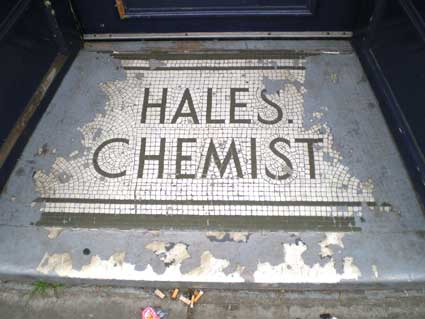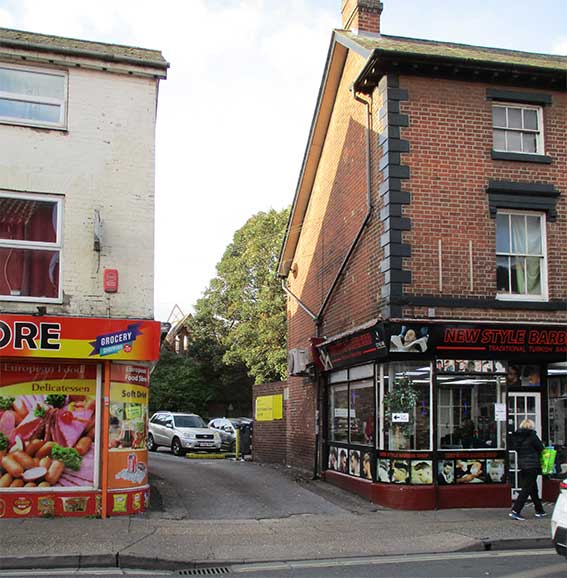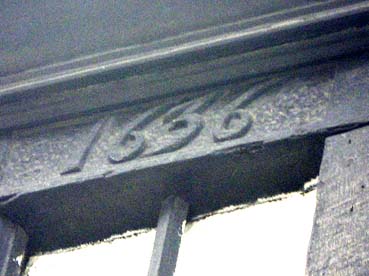Hales Chemist / St Helens Street, Yard behind Turners
Bldgs
12 St Helens Street
While the more high profile chemist's shop lettering
from J.A.
Symonds in Upper Brook Street celebrates the early marketing of
Kodak
films, another similar business in 12 St Helens Street (opposite The
Regent)
has a much more fugitive, but equally appealing example of trade
lettering.
We noticed by chance that during the period between the shop's closure
and
its reopening as a bespoke tailor's, that the lettering 'HALES CHEMIST'
was picked out in a rather attractive ceramic mosaic on the front step.
Generations of visitors to the little shop must have stepped over this
lettering;
we wonder how many people noticed the name beneath their feet. Before
we
had a chance to photograph the step, the new owners covered it with
grey
paint. However, wear and tear are rapidly revealing the lettering;
here's
how it looked in March, 2004. [Repainted 2005, but lettering showing
through slowly! [Update 2008:
this shop is empty once again, so no feet
will wear away the painted surface for the time being.]
 2004 image
2004 image
Another remnant of a chemist's shop exists on Fore
Street, opposite Isaac Lord. For other (better preserved) tiled doorways, see 'E.Smith', Woodbridge, 'Roll', Wells-Next-The Sea and 'Smith', Harwich; also Ann Williams' fine collection
(see Links).
 2010
2010
 2012
2012
[UPDATE May
2010:
Since the demise of the bespoke tailoring business at this address, a
continental grocery shop has opened and the footfall across this mosaic
step has increased noticeably. The full lettering emerges from the
coating of grey paint and, amongst the detritus of modern life
(dog-ends, gum, litter) and
'HALES.
CHEMIST'
is once more revealed (with rather puzzling full stop
after the first word). The last of the photographs above is from March
2012.
G.W. Hales the Chemist once traded from premises on the corner of Upper
Brook Street and Tacket Street. They also had a shop in Wherstead Road.
See our page about Price the shoe shop
for the Tacket Street shops building bearing the 'G.W.H.' tablet. For
another lettered chemist's premises see 'E.J.
Owles' in Fore Street.
 2023 image
2023 image
[UPDATE 17.10.2023:
Interestingly, in the 21st century, the new owners have cleaned up the
mosaic step and it is now the threshold of a Eurpean grocer's shop.]
14-16 St Helens Street
And here's a shot from the opposite side of the
road.
Two cartouches above, coincidentally, Finch Chemist:
the
one on the left painted on the wall, the one on the right a shaped
board
attached to the brickwork. Both bear the signs of obliteration of trade
lettering by coats of paint. To the left of the old chemist's shop we
find:
'TURNERS
BUILDINGS'
incised into a masonry strip above numbers 14 to 16
St Helens Street. The photograph (below right) taken in 2001 shows the
lettering
- clearer in the close-up - bisected by a metal road sign projecting
out
from the wall at right angles. The period photograph at bottom shows
that
this has existed for many years:

 2001 images
2001 images
Here is the shop of R.W. Fox, bookseller and stationer,
in 1909. The
proprietor
stands proudly in the centre of grand displays of publications, news
hoardings
and gas lights. On the right is a glimpse of 'St Helens Drug Store'
(the
lettering on the shelf below the carboy in the window), so a chemist's
business
has existed on this site for about a century. The upper right of the
photograph
(which is enlarged below) shows the same 'Turners' lettering which
exists
today with the 'Buildings' part obscured by the projecting trader's
sign.

Somehow this simple example of a lost age of
shop-keeping sharpens the
sense
of loss when walking the streets of our town. This web page was created
in March 2004, when the announcement had just been made of the closure
in
June, 2004 of Martin & Newby's
long-standing
hardware, tools and electrical premises in Fore Street. We seem as a
consumer
society to be using our purchasing power to favour mobile telephone
shops,
charity shops and short-lived cheap-jack shops over 'proper shops'
which
sell things that everyone, presumably, has to buy. How many
greengrocers,
bakers, butchers, electrical and hardware shops have closed down in
recent
decades? Those fortress-like supermarkets and warehouse DIY shops on
the
outskirts of the town continue to take away volumes of trade and
destroy
individual service from a real person behind a counter. There are still
one or two old-style businesses in Ipswich such as Browne's Menswear
opposite
Sainsbury's in Upper Brook Street. [UPDATE:
in c.2020 this building was converted into a fish restaurant.]
[UPDATE 28.1.208: 'As
the caption says, the Coffee Bar is on the right, and on the left was a
cycle dealer named Taylor, if memory serves. John Bulow-Osborne'.]
 1960
image courtesy John Bulow-Osborne
1960
image courtesy John Bulow-Osborne
John's suprising view of the yard behind Turners Buildings reveals the Church of St Michael in the background, but
also a terraced rown of (six?) houses standing at right-angles to St
Helens Street and reaching almost to the church wall. They have their
own street lamp. The 2023 view of the yard entrance (shown below)
reveals that
these have been demolished and the whole area is now used for car
parking. This seems to be a case, common in the Courts & yards, where gardens behind
buildings were in-filled with (often poor quality) housing to raise
revenue for the owners. Also note the ruins of St
Michaels Church –once dominant at the rear of this view – seen above
the mass of ivy.
 2023 image
2023 image
The 1902 map detail clearly shows the six houses built at an
angle to St Helens Street,just north of the Church of St Michael. The
'P.H.' (Public House) to the east is the Mitre on the corner of Bond
Street. The two public houses marked to the west in Upper Orwell Street
are The Beehive (a rather fine mock half-timbered building – and a sad
loss) with The Duke's Head below it (later the Co-op Funeral Service).
The tramway can be clearly seen in the centre of the roads either side
of Majors Corner.
 1902 map
1902 map
6 St Helens Street ('1636')
A few doors down from the former Hales shop is a
tiny,
ancient building opposite the Regent Theatre.
Empty and in poor condition some years ago, it was refurbished and the
original internal beams exposed against white washed plasterwork walls.
It is now an internet cafe open for long hours. As we waited in a car
at the Majors Corner traffic lights one day we noticed a date in relief
numerals painted the same black as the surround on one of the upper
beams: '1636'.
 -
- c. 2014 images
c. 2014 images
The carved numerals visible in the enhanced close-up
below appear to be original, making this a building of some age; it
would be interesting to discover the dates of surrounding buildings.
The weathered trade sign in painted wood of a former tenant is still
attached to the upper wall, projecting at right-angles to the frontage.
We can make out:
A..[RT?; UCTIONS?]'
ANT.. [IQUES]
Art No...[uveau]'.
It obviously wasn't worth removing! The exterior with its little bay
and dormer windows do not appear to have heavy restoration, hence the
survival of this anachronistic sign. Anyone know the name of the
antiques trader formerly at this address?
 -
-
As John Norman points out in one of his 'Ipswich icons'
columns: 'This is a typical example of a Tudor house, of which there
were considerable numbers in Ipswich. It is almost certain, given the
location, that trade has been carried out from the front room of this
property since before America was a colony.' A 'Kindred Spirits'
reflection on the age of this house appears at the bottom of our County Hall page.
Interestingly, these characters carved above the
windows resemble those cast into the water-spouting of the Almshouses. More St
Helens Street lettering can be found on the
page for H.W.
Turner, IBH, County Hall, also the
Regent Theatre on the Bethesda page.
British Listed buildings (see Links)
describes this building.
"6, St Helen's Street (Listed Grade II). An early C17 timber-framed
building. 2 storeys and attics. The upper storey has exposed
timber-framing with plaster infill and a central splayed oriel window
with leaded easements flanked by high level mullioned windows. It has a
moulded sill beam and a lintel carved with the date 1636. Roof tiled
(old tiles), with a central flat headed dormer with leaded casements.
The interior has exposed moulded ceiling beams and joists."
Home
Please email any comments
and contributions by clicking here.
Search Ipswich
Historic Lettering
©2004 Copyright
throughout the Ipswich
Historic Lettering site: Borin Van Loon
No reproduction of text or images without express written permission
 2023 image
2023 image 2004 image
2004 image 2010
2010
 2012
2012 2023 image
2023 image
 2001 images
2001 images
 1960
image courtesy John Bulow-Osborne
1960
image courtesy John Bulow-Osborne 2023 image
2023 image 1902 map
1902 map -
- c. 2014 images
c. 2014 images -
-